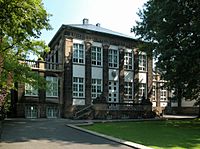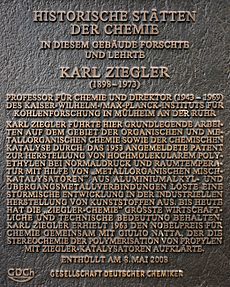Karl Ziegler facts for kids
Quick facts for kids
Karl Ziegler
|
|
|---|---|

Karl Ziegler
|
|
| Born |
Karl Waldemar Ziegler
26 November 1898 Helsa near Kassel, German Empire
|
| Died | 12 August 1973 (aged 74) |
| Nationality | German |
| Alma mater | University of Marburg |
| Known for | Ziegler–Natta catalyst Ziegler process Wohl–Ziegler bromination Thorpe–Ziegler reaction Organoaluminium chemistry Organolithium reagent |
| Awards | Liebig Medal (1935) War Merit Cross 2nd Class (1940) Werner von Siemens Ring (1961) Nobel Prize for Chemistry (1963) |
| Scientific career | |
| Fields | Organic chemistry |
| Institutions | Goethe University Frankfurt University of Heidelberg University of Halle-Saale Max Planck Institute für Kohlenforschung |
| Doctoral advisor | Karl von Auwers |
Karl Waldemar Ziegler (26 November 1898 – 12 August 1973) was a German chemist. He won the Nobel Prize in Chemistry in 1963, with Giulio Natta, for work on polymers. He is also known for his work involving free-radicals, many-membered rings, and organometallic compounds, as well as the development of Ziegler–Natta catalyst. One of many awards Ziegler received was the Werner von Siemens Ring in 1960 jointly with Otto Bayer and Walter Reppe, for expanding the scientific knowledge of and the technical development of new synthetic materials.
Contents
Early life and education
Karl Ziegler was born on 26 November 1898 in Helsa near Kassel, Germany and was the second son of Karl Ziegler, a Lutheran minister, and Luise Rall Ziegler. He showed an eagerness for science at an early age. He progressed through schooling and read extensively beyond his high school curriculum.
Ziegler studied at the University of Marburg and was able to omit his first two semesters of study due to his extensive background knowledge. His studies were interrupted in 1918 when he was deployed to the front as a soldier to serve in World War I. He received a doctorate from the University of Marburg in 1920.
Career
Ziegler briefly lectured at the University of Marburg and the University of Frankfurt.
In 1926 he became a professor at the University of Heidelberg where he spent the next ten years researching new advances in organic chemistry. In 1933 Ziegler published his first major work on large ring systems, "Vielgliedrige Ringsysteme".
In 1936 he became Professor and Director of the Chemical Institute (Chemisches Institut) at the University of Halle-Saale and was also a visiting lecturer at the University of Chicago. Ziegler, who was a Patron Member of the SS received the War Merit Cross 2nd Class in October 1940.
From 1943 until 1969, Ziegler was the Director of the Max Planck Institute for Coal Research (Max-Planck-Institut fur Kohlenforschung).
Karl Ziegler was credited with much of the postwar resurrection of chemical research in Germany and helped found the German Chemical Society (Gesellschaft Deutscher Chemiker) in 1949. He served as president for five years. He was also the president of the German Society for Petroleum Science and Coal Chemistry (Deutsche Gesellschaft für Mineralölwissenschaft und Kohlechemie), from 1954 to 1957. In 1971, The Royal Society, London, elected him as a Foreign Member.
Scientific advancements
Ziegler's research spans a wide range of topics within the field of chemistry. As a young professor, Ziegler posed the question: what factors contribute to the dissociation of carbon-carbon bonds in substituted ethane derivatives? This question was to lead Ziegler on to a study of free radicals, organometallics, ring compounds, and, finally, polymerization processes.
Polyethylene
Since Ziegler was working at the Max Planck Institute for Coal Research, ethylene was readily available as a byproduct from coal gas. Because of this cheap feedstock of ethylene and the relevance to the coal industry, Ziegler began experimenting with ethylene, and made it a goal to synthesize polyethylene of high molecular weight. His attempts were thwarted because a competing elimination reaction kept occurring causing an anomalous result: instead of ethylene being converted into a mixture of higher aluminum alkyls, its dimer, 1-butene, was almost the only product. It was reasoned that a contaminant must have been present to cause this unexpected elimination reaction, and the cause was eventually determined to be traces of nickel salts. Ziegler realized the significance of this finding; if a nickel salt could have such a dramatic influence on the course of an ethylene-aluminum alkyl reaction, then perhaps another metal might delay the elimination reaction. Ziegler and his student H. Breil found that salts of chromium, zirconium, and especially titanium did not promote the R2AlH-elimination but, instead, enormously accelerated the "growth" reaction. Simply passing ethylene, at atmospheric pressure, into a catalytic amount of TiCl3 and Et2AlCl dissolved in a higher alkane led to the prompt deposition of polyethylene. Ziegler was able to obtain high molecular weight polyethylene (MW > 30,000) and, most importantly, to do so at low ethylene pressures.
Personal life
In 1922, Ziegler married Maria Kurtz. They had two children, Erhart and Marianna. His daughter, Dr. Marianna Ziegler Witte was a doctor of medicine and married a chief physical of a children's hospital (at that time) in the Ruhr. His son, Dr. Erhart Ziegler, became a physicist and patent attorney.
Art collector
Ziegler and his wife were great lovers of the arts, particularly paintings. Karl and Maria would present each other with paintings for birthdays, Christmases, and anniversaries. They amassed a large collection of paintings, not necessarily of one particular period, but of paintings they enjoyed. Maria, being an avid gardener, particularly enjoyed flower paintings by Emil Nolde, Erich Heckel, Oskar Kokoschka, and Karl Schmidt-Rottluff. Karl enjoyed pictures of the places that he and his wife called home, including pictures of Halle and the Ruhr valley. Forty-two images from their shared collection were incorporated into a foundation, bequeathed to the Mülheim Ziegler Art Museum.
Death
Karl Ziegler died in Mülheim, Germany on 12 August 1973; his wife died in 1980.
Interesting facts about Karl Ziegler
- A legend has it that an introductory physics textbook first sparked Ziegler's interest in science and drove him to perform experiments in his home and to read extensively beyond his high school curriculum.
- Ziegler enjoyed traveling around the world with his family, especially on cruises. He even charted special cruises and airplanes for eclipse viewing.
- As a man of many discoveries, Karl Ziegler was also a man of many patents. As a result of his patent agreement with the Max Planck Institute, Ziegler was a wealthy man.
- With part of this wealth, he set up the Ziegler Fund with some 40 million deutsche marks to support the institute's research. Another namesake is the Karl-Ziegler-Schule, an urban high school that was founded on 4 December 1974, renaming a previously existing school. The school is located in Mülheim, Germany.
- For his work on many-membered ring compounds and in free-radical chemistry Ziegler was awarded the Liebig Memorial Medal in 1935.
- Karl Ziegler has five grandchildren by his daughter, and five by his son.
Awards and honours
Karl Ziegler received many awards and honors. The following highlights some of the most significant awards:
- Liebig-Denkmünze medal (1935); This medal was awarded by the present day German Chemical Society and is given to a German chemist for their outstanding accomplishments and creativity. Ziegler received the award because of his work in the synthesis of multi-membered ring systems and stable tri-valent carbon radicals.
- War Merit Cross, 2nd class (19 October 1940)
- Carl Duisberg Plakette (1953); This award is given for outstanding service to the promotion of chemistry from the German Chemical Society.
- Lavoisier Medal (1955); This award is given by the French Chemical Society to scientists in various disciplines of chemistry.
- Carl Engler Medal (1958); This award is given by the German Society of Petroleum Science and Coal Chemicals, of which he was the president in earlier years.
- Werner von Siemens Ring (1960); This ring is awarded by the Werner von Siemens Foundation and is considered the highest German award for individuals who by their performance and skills opened up new technological paths.
- Nobel Prize in Chemistry (1963); "[His] excellent work on organometallic compounds has unexpectedly led to new polymerization reactions and thus paved the way for new and highly useful industrial processes."
- Swinburne Medal of the Plastics Institute, London (1964); This award recognizes an individual who has made a significant advancement to the science, engineering or technology of plastics.
- Grand Merit Cross with Star and Sash (Großes Verdienstkreuz mit Stern und Schulterband) of the Federal Republic of Germany (1964)
- International Synthetic Rubber Medal of Rubber and Plastics Age (1967)
- Grand Federal Cross of Merit (Order of Merit of the Federal Republic of Germany)(1969); Ziegler was given this award for his work in the area of Science and Technology.
- Pour le Mérite for Arts and Sciences (formerly Peace Class) (1969)
- Foreign Member of the Royal Society (1971)
- Wilhelm Exner Medal (1971).
- Memorial tablet of the German Chemical Society under the Historic Landmarks of Chemistry program (Historische Stätten der Chemie) at the Max Planck Institute for Coal Research in Mülheim an der Ruhr (2008)
- Honorary doctorates from the Technical University of Hannover, Giessen University, University of Heidelberg and Darmstadt Technical University
- The Karl-Ziegler-Schule in Mülheim was named after Ziegler
- The Karl Ziegler Foundation is located at the German Chemical Society and gives the Science Award, the Karl Ziegler Prize (worth 50,000 euros)
See also
 In Spanish: Karl Ziegler para niños
In Spanish: Karl Ziegler para niños
- Dienone–phenol rearrangement
- List of Nobel laureates in Chemistry



